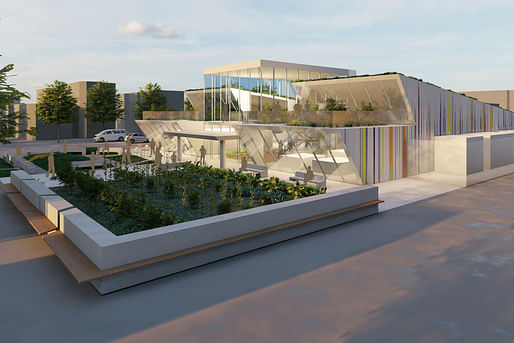
Now in its fifth edition, the CAB Student Ideas Competition, hosted by the Chicago Architecture Biennial (CAB), encourages middle and high school students to explore design in their immediate built environment. The competition invited students to discover how "design can play a role in creating shared spaces and improving communities."
For the Spring 2021 iteration, participants were inspired by the Biennial's theme, The Available City, led by Artistic Director David Brown. Each project had to answer the following question: "How can existing urban spaces be reimagined to better reflect the needs and interests of local residents?"
Students were also tasked to develop projects that addressed architecture and the built environment through "varying disciplines including design, the humanities, visual and performing arts, and STEM fields."
The contest was open and free to Chicagoland students in 7th through 12th grade. Winning projects and teams were recognized in a virtual ceremony. The first, second, and third place winners also received cash and technology prizes. "The winning entries have been identified for being community-specific, imaginative, and exhibiting a creative use of materials," the organizers pointed out.
Following are the first, second, and third place winners and their projects.
Design Team: ACE Chicago Team 5
Instructor: Hiba Bhatty and Matt Gilbert
School: Multiple
Project Description: "The Floating Village" is a homeless shelter that addresses basic (Rest), psychological (Revive), and self-fulfillment (Return) needs that are affected by homelessness. The shelter is located in a vacant parcel of land in the neighborhood of Mckinley Park. The proximity near a large park, grocery stores, and other utilities are easily accessible for the residents in the Floating Village, contributing to the basic needs of individuals.
The Village reimagines the Maslow’s hierarchy of needs by dividing rooms and services into three categories: Rest, Revive, and Return. For Rest, since the majority of those that are homeless are individuals, we have provided a series of single resident occupancies with shared laundry facilities above a community resource center. For Revive, we shaped the village in a circle so each unit can appreciate the internal green courtyard, and although the users are living on their own, there is a feeling of belonging to a community, like a village! Lastly, Return encompasses the educational, employment, and mental health resources for the community. From a library to fuel your intellectual juices, a yoga/meditation room to rejuvenate your spiritual side to a fitness center to exercise, and even a donut shop as a way to reward yourself at the end of the day, our village truly unites people in all of its spaces.
Design Team: Owen Summers
Instructor: Mr. Devin Mays
School: Chi-Arts (Chicago High School for the Arts)
Project Description: This project reimagines spaces in neighborhoods by creating an elevated space that would otherwise be flat. This is done so as to create a public space that gives anybody the ability to get a bird’s eye perspective of their community. Chicago and its neighborhoods are built on relatively flat grounds with little to no change in elevation. This means most residents only ever get to see their neighborhoods through the lens of a street view or their windows. If this proposed project was implemented, members of any given community could easily go to these elevated spaces and get a wider perspective of their neighborhoods. Because of this, residents are given the chance to more easily visualize their communities and reimagine their place in it.

Design Team: Rosina Iniguez, Ian Hudson, and Jason Hart
Instructor: David Rader
School: Jones College Prep and Muchin College Prep
Project Description: Our project, the Grocery Garden, proposes a new bodega on this vacant site at W. 15th Street and Kedzie Avenue. Our aim is to provide a recognizable landmark with accessible and safe public space that alleviates the food desert and plays a positive role in community life. The bodega is a small grocery store, offering healthy food options for residents. We included a community garden against W. 15th Street, allowing residents to grow their own produce and gather. This allows the bodega to offer educational programs and for residents to see where their food comes from. The bodega also offers educational and training spaces for trades-based jobs, such as a training kitchen and multi-purpose educational spaces for workshops and training. The sustainable features of the bodega, including a sloping green roof and self-shading glass, reduce energy consumption and surface water runoff. These features will improve public health and improve the quality of the neighborhood. The bodega’s colorful facade and height ensure that it will become a neighborhood landmark, becoming a destination for residents and enhancing the public life of North Lawndale.
HONORABLE MENTIONS
To learn more about the 2021 CAB Student Ideas Competition and all its winners click here.
1 Comment
These are better renderings and concepts than I see from some advanced architecture grad students.
Block this user
Are you sure you want to block this user and hide all related comments throughout the site?
Archinect
This is your first comment on Archinect. Your comment will be visible once approved.